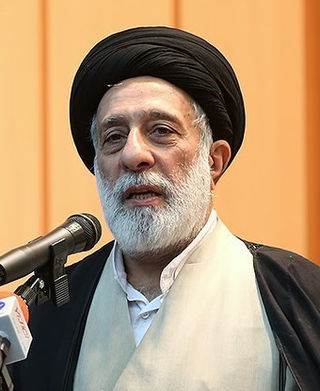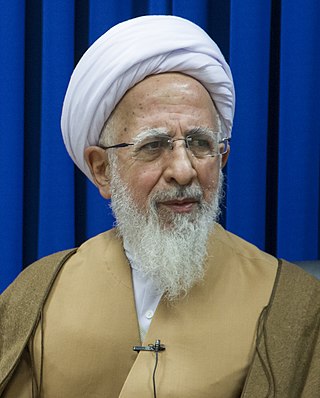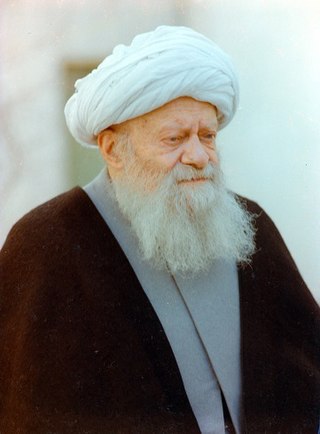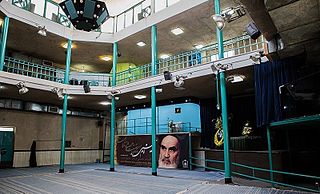
Ayatollah Ruhollah Khomeini was an Iranian revolutionary, politician and religious leader who served as the first supreme leader of Iran from 1979 until his death in 1989. He was the founder of the Islamic Republic of Iran and the leader of the 1979 Iranian Revolution, which saw the overthrow of Shah Mohammad Reza Pahlavi and the end of the Iranian monarchy. Following the revolution, Khomeini became the country's first supreme leader, a position created in the constitution of the Islamic Republic as the highest-ranking political and religious authority of the nation, which he held until his death. Most of his period in power was taken up by the Iran–Iraq War of 1980–1988. He was succeeded by Ali Khamenei on 4 June 1989.

Mohammad Hosseini Beheshti was an Iranian jurist, philosopher, cleric and politician who was known as the second person in the political hierarchy of Iran after the Revolution. Beheshti is considered to have been the primary architect of Iran's post-revolution constitution, as well as the administrative structure of the Islamic republic. Beheshti is also known to have selected and trained several prominent politicians in the Islamic Republic, such as former presidents Hassan Rouhani and Mohammad Khatami, Ali Akbar Velayati, Mohammad Javad Larijani, Ali Fallahian, and Mostafa Pourmohammadi. Beheshti also served as the Secretary General of the Islamic Republic Party, and was the head of the Iranian judicial system. He further served as Chairman of the Council of Islamic Revolution, and the Assembly of Experts. Beheshti earned a PhD in philosophy, and was fluent in English, German and Arabic.

Mohammad-Javad Bahonar was a Shia Iranian theologian and politician who served as the Prime Minister of Iran for less than one month in August 1981. Bahonar and other members of Mohammad-Ali Rajai's government were assassinated by Mujahideen-e Khalq.

Ali Ardeshir Larijani is an Iranian conservative politician, philosopher and former military officer in the Islamic Revolutionary Guard Corps, who served as the Speaker of the Parliament of Iran from 2008 to 2020. He is currently member of the Expediency Discernment Council.

Mohammad Yazdi was an Iranian conservative and principlist cleric who served as the head of Judiciary System of Iran between 1989 and 1999. In 2015, he was elected to lead Iran's Assembly of Experts, defeating Akbar Hashemi Rafsanjani, a former president, by a vote count of 47 to 24.

Ayatollah Mohammad Reza Mahdavi Kani was an Iranian Shia cleric, writer and conservative and principlist politician who was Acting Prime Minister of Iran from 2 September until 29 October 1981. Before that, he was Minister of Interior in the cabinets of Mohammad-Ali Rajai and Mohammad-Javad Bahonar. He was the leader of Combatant Clergy Association and Chairman of the Assembly of Experts and also founder and president of Imam Sadiq University.

Ayatollah Mohammad Mofatteh was an Iranian philosopher, theologian, and political activist, born in Famenin, Hamadan, Iran. After he finished his primary education in Hamadan, he left for the Islamic Seminary in Qom, where he was taught by reputable teachers such as Ayatollah Muhammad Hujjat Kuh-Kamari, Ayatollah Sayyed Hossein Tabatabei Borujerdi, Grand Ayatollah Sayyid Ruhollah Mūsavi Khomeini, Ayatollah Mohammad-Reza Golpaygani, Ayatollah Marashi, and Allameh Tabatabie. He continued his studies at seminary and at the same time studied philosophy at Tehran University, where he earned his PhD and became a professor and a dean of colleague.

Sayyid Hadi Khamenei is an Iranian reformist politician, mujtahid and linguist. He is a key member of the reformist Association of Combatant Clerics, and a former deputy of the Majlis of Iran representing a district in Tehran.

Sadeq Ardeshir Larijani, better known as Amoli Larijani, is an Iranian scholar, conservative politician, and current chairman of Expediency Discernment Council. He is the former and fifth Chief Justice of the judicial system of Iran after the 1979 revolution.

Abdollah Javadi Amoli is an Iranian Twelver Shi'a Marja. He is a conservative and principlist Iranian politician, philosopher and one of the prominent Islamic scholars of the Hawza. The official website for his scientific foundation, Isra, states that his ideas and views have been guidance to the Islamic Republic of Iran since the 1979 Islamic Revolution, and that "his strategic and enlightening guidance" has been "extremely constructive" during the past three decades. He is known as one of the biggest critics of the banking system in Iran.

Sayyid Ahmad Khomeini was the younger son of Ayatollah Ruhollah Khomeini and father of Hassan Khomeini. He was the "right-hand" of his father before, during and after the Iranian Revolution. He was a link between Ruhollah Khomeini and officials and people. He had several decision-making positions.

Ayatollah Mirza Hashem Amoli Larijani was an Iranian Shia Marja' and scholar of jurisprudence.

Hassan Hassanzadeh Amoli was an Iranian Shi'ite theologian known for his mystical tendencies and Islamic philosophy. He was among clerics who overcomed the traditional opposition to teaching philosophy courses at Shi'ite seminaries. He wrote many books in philosophy, mysticism, mathematics, astronomy, Persian and Arabic literature.He interpreted the Islamic philosophical tradition in a similar way to Mulla Sadra, which is a reconciliation of religion, reason and mysticism. His books include Sharh fusus al-hikam, Tashih nahj al-balagha, Insan dar 'urf-i 'irfan, Tashih kalila wa dimna.
"To the Youth in Europe and North America" is an online open letter written on 21 January 2015 by Iran's Supreme Leader, Ayatollah Ali Khamenei. According to Al-Monitor, it may be the first time that young people in the West have been directly addressed by a senior Islamic cleric about his religion.

Jamaran Hussainiya was the house of Ruhollah Khomeini, the founder of the Islamic Republic of Iran, in Jamaran village. On 23 January 1980, Ayatollah Khomeini went to Tehran from Qom to cure a heart ailment. According to doctors recommendation, the weather of Qom did not agree with him. The house of Khomeini was next to the Hussainiya in Jamaran village. The house was linked to a large mosque by a metal platform. Khomeini often walked up a flight of stairs leading from his house to the balcony of the mosque, from which he often spoke.

On 8 January 2017, Akbar Hashemi Rafsanjani, the fourth President of Iran and the country's Chairman of Expediency Discernment Council, died at the age of 82 after suffering a heart attack. He was transferred unconscious to a hospital in Tajrish, north Tehran. Attempts at cardiopulmonary resuscitation for more than an hour trying to revive him were unsuccessful and he died at 19:30 local time (UTC+3:30).

Ruhollah Khomeini's life in exile was the period that Grand Ayatollah Ruhollah Khomeini spent from 1964 to 1979 in Turkey, Iraq and France, after Mohamed Reza Shah Pahlavi had arrested him twice for dissent from his “White Revolution” announced in 1963. Ayatollah Khomeini was invited back to Iran by the government, and returned to Tehran from exile on 1979.

The Khamenei family or Khamenei dynasty is among the Iranian Azeri Sayyid families who claim to be descendants of the fourth Imam of Shia Islam, Ali ibn Husayn Zayn al-Abidin — according to the "Khamenei family tree". Their dwelling place(s) were/are in Azerbaijan (Iran), Najaf, Tafresh, etc.

Seyed Kazem Noor Mofidi is a Supreme Leader's representative in Golestan Province, the leader of congregational Friday prayers of Gorgan, and a member of the Assembly of Experts in Iran. He is considered the oldest Friday prayer leader in the country and the only representative of the reformist Supreme Leader in Iran.

Sayyid Mohammad Khamenei is an Iranian cleric and politician. He is the older brother of Ali Khamenei, the current Supreme Leader of Iran, and Hadi Khamenei. Currently, he is the president of Iranology Foundation, and Sadra Islamic Wisdom Foundation, he is a professor at Allameh Tabataba'i University, School of International Relations and Al-Zahra University. He was also one of the compilers of the Constitution of the Islamic Republic of Iran and a member for the Islamic Consultative Assembly representing Mashhad.



















